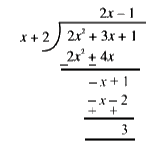A is a set having n elements. A subset P of A is chosen at random. The set A is reconstructed by replacing the elements of A. A subset Q of A is again chosen at random. Find the probability that P and Q have no common elements.
Let A={a1,a2,….An}
For an element ai∈A and two subset P and Q there four possibilities.

numbers of ways of choosing subset P=2n
As the elements have been replaced after the subset P has been chosen, choosing now a subset Q is as good as a fresh beginning.
Number of ways of choosing subset Q=2n
As the number of ways of choosing P and Q are independent, we have number of ways of choosing two subset P and Q =(2n)(2n)=4n
Now a particular element ai∈A will not belong to either P or Q in 3 ways. The no. of ways in which no ai∈A belong to both P and Q =3×3×...3 to n times
=3n
The required probability = 3n4n=(34)n
Topper's Solved these Questions
- PROBABILITYBOOK - AAKASH INSTITUTECHAPTER - PROBABILITYEXERCISE - TRY YOURSELF
36 Videos
- PROBABILITYBOOK - AAKASH INSTITUTECHAPTER - PROBABILITYEXERCISE - ASSIGNMENT (SECTION - A Competition Level Questions)
114 Videos
- PRINCIPLE OF MATHEMATICAL BOOK - AAKASH INSTITUTECHAPTER - PRINCIPLE OF MATHEMATICAL EXERCISE - Section-D:(Assertion-Reason Type Questions)
12 Videos
- RELATIONS AND FUNCTIONS BOOK - AAKASH INSTITUTECHAPTER - RELATIONS AND FUNCTIONS EXERCISE - Assignment (Section - J) Aakash Challengers Questions
8 Videos
Similar Questions
A is a set containing n elements. A subset P of A is chosen at random. The set A is reconstructed by replacing the elements of P. A subset Q is again chosen at random. The probability that P and Q are disjoint sets, is
View SolutionA is a set containing n elements. A subset P of A is chosen at random. The set A is reconstructed by replacing the elements of P. A subset Q is again chosen at random. The Probability that Q is a subset of P, is
View Solution
Knowledge Check
A is a set containing n elements. A subset P of A is chosen at random. The set A is reconstructed by replacing the elements of P. A subset Q is again chosen at random. The probability that P =Q, is
A12nB(34)nC(14)nD(23)nA is a set containing n elements. A subset P of A is chosen at random. The set A is reconstructed by replacing the elements of P. A subset Q is again chosen at random. The Probability that P∪Q=A, is
A12nB(34)nCn(34)nDn3(34)nA is a set containing n elements. A subset P of A is chosen at random. The set A is reconstructed by replacing the elements of P. A subset Q is again chosen at random. The Probability that P and Q have equal number of elements, is
A(34)nB.2nCn4nC.2nCn−14nDn24n
A is a set containing n elements. A subset P of A is chosen at random. The set A is reconstructed by replacing the elements of P. A subset Q is again chosen at random. The Probability that P∩Q contain just one element, is
View SolutionA is a set containing n elements. A subset P of A is chosen at random. The set A is reconstructed by replacing the elements of P. A subset Q is again chosen at random. The Probability that P∪Q contain just one element, is
View SolutionA is a set containing n elements. A subset P of A is chosen at random. The set A is reconstructed by replacing the elements of P. A subset Q is again chosen at random. The probability that Q contains just one element more than P, is
View SolutionA is a set containing n elements . A subset of A is chosen at random. The set A is reconstructed by replacing the elements of P.A subet Q is again chosen at random. The number of ways of selecting P and Q, is .
View SolutionLet A be a set containing elements. A subset P of the set A is chosen at random. The set A is reconstructed by replacing the elements of P, and another subset Q of A is chosen at random. The probability that P∩Q contains exactly m(m<n) elements, is
View Solution
